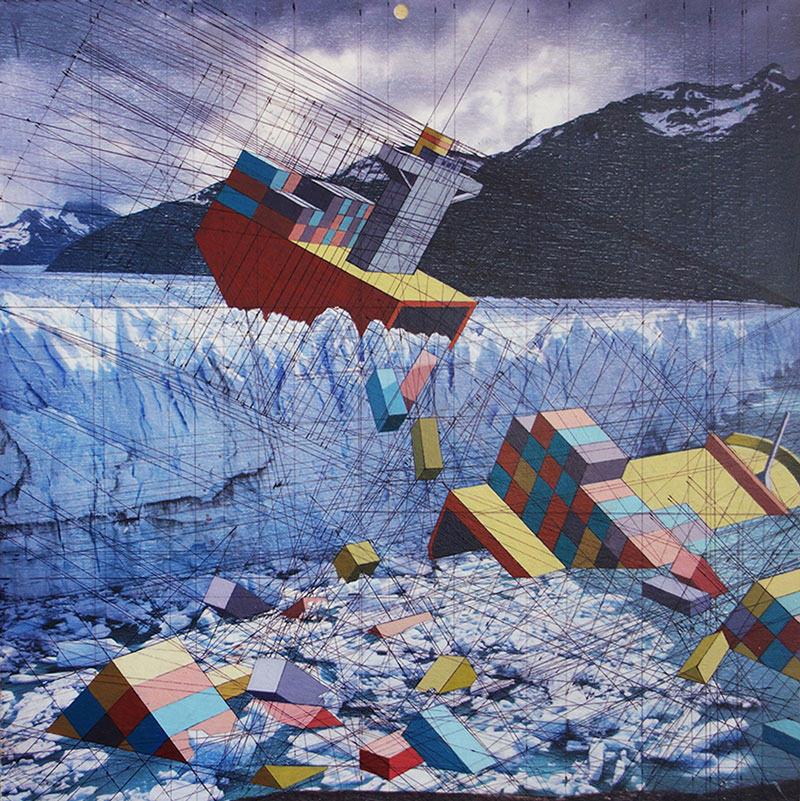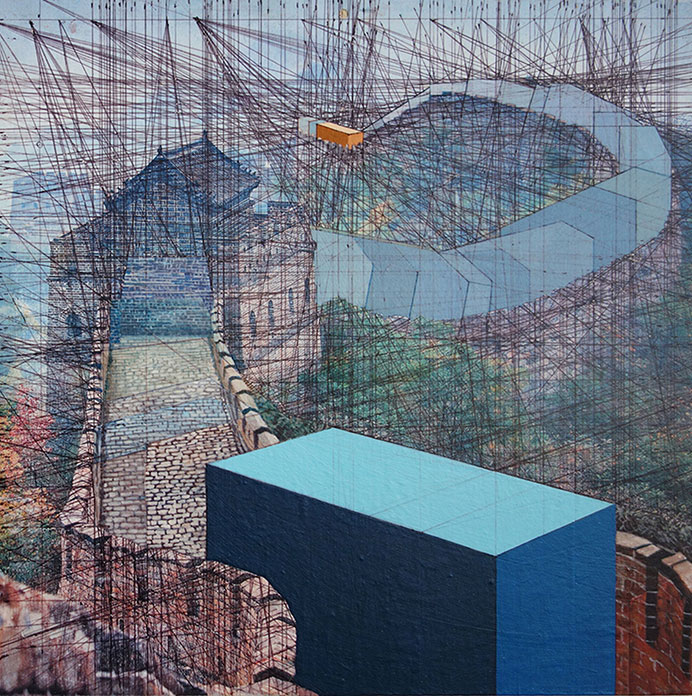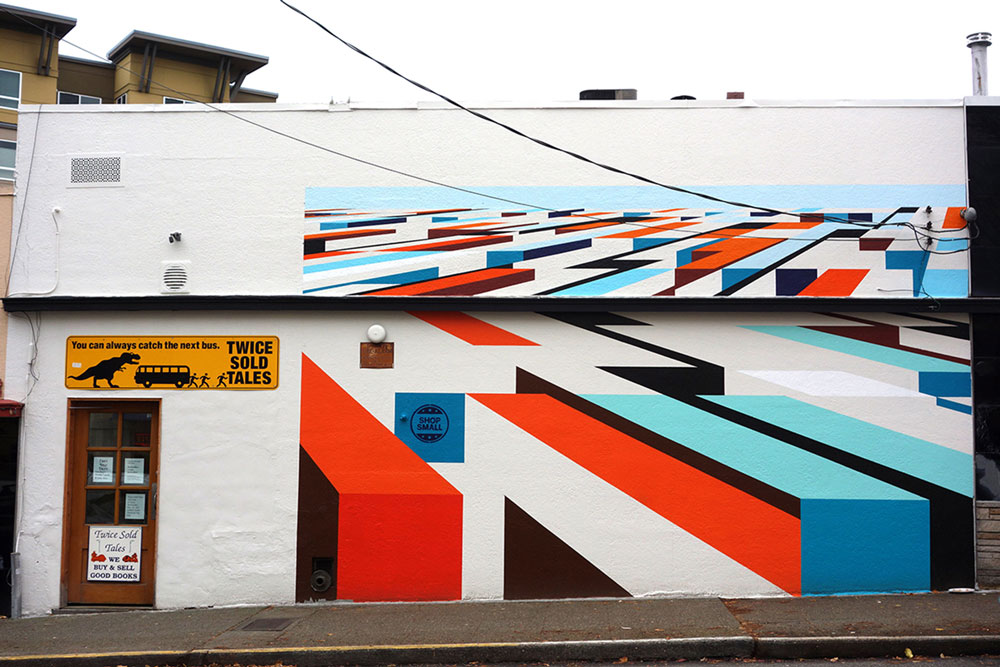Is it conflict inspiring beauty or a vision into our austere future? The work of Mary Iverson juxtaposes landscape and industry held together with fierce passion.
You originally studies science as an undergrad. Can you tell us about the correlation between your work and your interest in science?
Primarily, I enjoy observation – it leads to curiosity, and curiosity for me leads to learning about systems, patterns, and interconnectedness. I used to think this made me a scientist, but when I got to know myself better, I realized this made me an artist!
How and when did your “Nature vs. Industry” thesis take root?
For about 10 years—from 1999 to 2009—I made paintings that were inspired by the shipping industry. I was initially drawn to the colors and shapes at the Port of Seattle, with its bright shipping containers, hulking megaships, and graceful orange container cranes. I found a lot of visual joy in observing the port as it grew.
My observation of the port’s growth led to a curiosity about the shipping industry in general. What I learned is there are two sides to the industry: the positive side, where trade is streamlined, and the transporting of goods is more cost effective, enabling global commerce, and the flip side, which supports the manufacturing, trade and disposal of an immense quantity of cheap goods, and the waste problems that follow. The shipping industry has made unbridled consumption possible, driven by practices that decrease costs, including the unregulated disposal of unwanted ships on the beaches of third world countries.
As I accumulated this knowledge, I grew more conflicted—my attraction to the shipping industry clashed with my love for the environment. At heart, I am an environmentalist, so to continue working authentically I needed to find a way to reconcile these two passions in my paintings. I began making collages, searching for a way to combine industrial, planar shapes with organic, natural imagery. The collage process led me to my current body of work.


Glacier
12x12in
Mixed Media Collage
2014
You like to travel to the places you depict in your work. What are those experiences like, and how does seeing things in person affect how the work is created?
My research trips to the sacred natural places that I paint make the whole process more enjoyable. My personal connection to a place is noticeable through my paintings. There is no substitute for actually experiencing a natural site in person. I need to sketch there, breathe the air, see the colors, and take my own reference photos from the perfect spot.
What other types of research do you do for your work?
I read port statistics from various websites, and I read Sierra magazine. I search online for the latest shipping disasters, and look for photos of the newest, biggest, megaships. Also, I follow twitter accounts such as @climatereality and @grist, as well as Instagram accounts from dockers around the world. And I hike in the woods.
How does your studio process differ from when you paint live on site?
I used to paint my oil landscapes strictly plein air. In 2000 I got a permit to bring my easel onto the container terminals at the Port of Seattle, and I painted there every day. I gained insight into the inner workings of the port—it was an amazing year!
These days, I use watercolors for plein air sketching because they are easy to hike with. I like to be in the moment, in the place, sinking into what I am doing and enjoying the sketching process. When I sketch on site these days, it’s just for me; I don’t worry about producing something to sell or what people will like.
Back in the studio, I have a controlled environment where I can work carefully on my large oil paintings. There are few variables in the studio, and I can keep a predictable schedule. Plein air work can be stressful because the session has to be timed just right to get the best light on the landscape. This can be challenging when I have to travel somewhere to sketch. I can wake up early on a clear day and head to Mount Rainier, but once I get there it might be raining or really cloudy and I can’t see the mountain. That stresses me out, big time. I am obsessed with weather apps!
At heart, I am an environmentalist, so to continue working authentically I needed to find a way to reconcile these two passions in my paintings.


Scene One China Wall
12x12in
Mixed Media Collage
2014
Your paintings come to life with a real sense of time in your animations. Can you tell us a little more about these short videos and how they came about?
While browsing through old travel books at Goodwill, I came across some images of the Great Wall of China, and I thought it would be great to show an “old meets new” technology comparison between the ancient wall and a new shipping container. It didn’t seem like it would be enough to just show a static image of one container sitting on the wall, so I made it move, frame by frame, along the wall in an animation. The message is, “Look out! The containers are coming!” Our world is changing fast.
In what ways has your work evolved over time?
I trust myself more these days. More and more, I allow myself to do what I want to do in my work, to go deeper into my personal interests, which fortunately has revealed some imagery that is interesting to others as well. I was trained initially as an illustrator, and success in that line of work involves collaborating with clients and your audience. So it’s been a process of quieting those collaborative voices. Not completely silencing them, but listening more to my own voice.
The imagery and painting style you use is very old, yet you’re depicting scenes of the possible future. The here and now almost seem skipped, is that a conscious decision?
Actually, my paintings are meant to awaken people to what is happening in the present. Human activity is changing the planet right now. My work is intended to say, “Pay attention! This is happening!” The reason I place containers in our favorite postcard views is to make the statement that if the destruction were happening in places we cherish (like the Grand Canyon or Mount Rainier National Park) we would take notice. The narrative might suggest a future apocalypse, and the style might harken back to classical realism, but the message is about what is happening right now.


Settlement, 12x12in, Mixed Media Collage, 2014
Brothers, 8x10in, Acrylic, Ink, Found Photo on Panel, 2015
How do you balance aesthetics and activism in your paintings?
For me, the aesthetics set the stage for the activism. It’s true I found my current imagery by attempting to resolve two conflicting passions. But I also found my imagery because I had reached a dead end aesthetically with both landscape painting and with purely geometric depictions of shipping containers. Creating a pure landscape painting doesn’t do it for me anymore, and a purely geometric depiction of the containers isn’t interesting enough either. It’s the combination of the two that feels right to me, and is satisfying both aesthetically and conceptually. I love the interplay between the natural forms and the perspectival geometry. That combination really hits home for me, and it also expresses a deep personal interest in communicating an environmental message.
How do you see yourself fitting into the “environmental art” category?
I just finished an illustration for Foreign Policy magazine, which I am very excited about! They asked me to do a piece on climate change, and I am stoked to be making a contribution to the political dialogue surrounding this issue.
How do you imagine your work being viewed in the future?
People will say that I predicted future cataclysmic events. They will also say that I predicted the future nostalgia we will have for the pristine places of the past.


Shop Small Mural, 2014
You’ve done a lot of public art, what have those experiences been like, and why do you think public art is important?
The most frequent comment I get from onlookers when I am painting a wall is “Thank you!” Beauty brings out the best in people. That’s why we need public art. Creating murals is a very intense process for me that I both love and dread. Nothing compares to seeing my work big on a wall, but nothing is harder to pull off, both physically and logistically. Being a muralist requires the support of others, and I am always grateful for the friends and colleagues who help me with projects. We also have a lot of fun in the process!
Beauty brings out the best in people. That’s why we need public art.
How does your Seattle location relate to your work?
The Port of Seattle is the main source of my inspiration for shipping container imagery. Also, Seattle is close to three very cool national parks that I visit frequently: Mount Rainier National Park, Olympic National Park, and North Cascades National Park.
You must be constantly thinking about the slow demise of our environment. How do you stay positive, and what keeps you going?
You’re right, except that now it’s a more rapid demise. Sometimes I feel powerless and I wish I could have a more direct impact on the environment—for instance helping to save a certain species from extinction. But my skills lie in the painting department, and I am committed to doing what I can with what I have.
What are the next steps for you as an artist?
I will continue on my journey of exploring iconic natural places for my paintings, and I hope to paint more murals. For the next several months I will be working on paintings for my show next December at Chandran Gallery in San Francisco.


Rainier View, 24x36in, Oil on Canvas, 2015
Shipbreaking, Torrey Pines State Preserve, 32x50in, Oil on Canvas, 2014